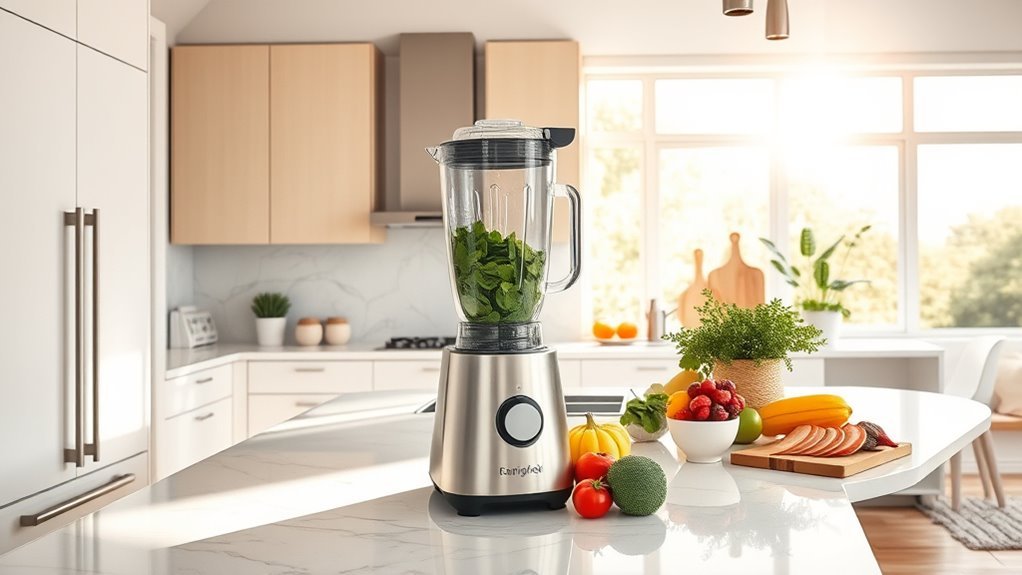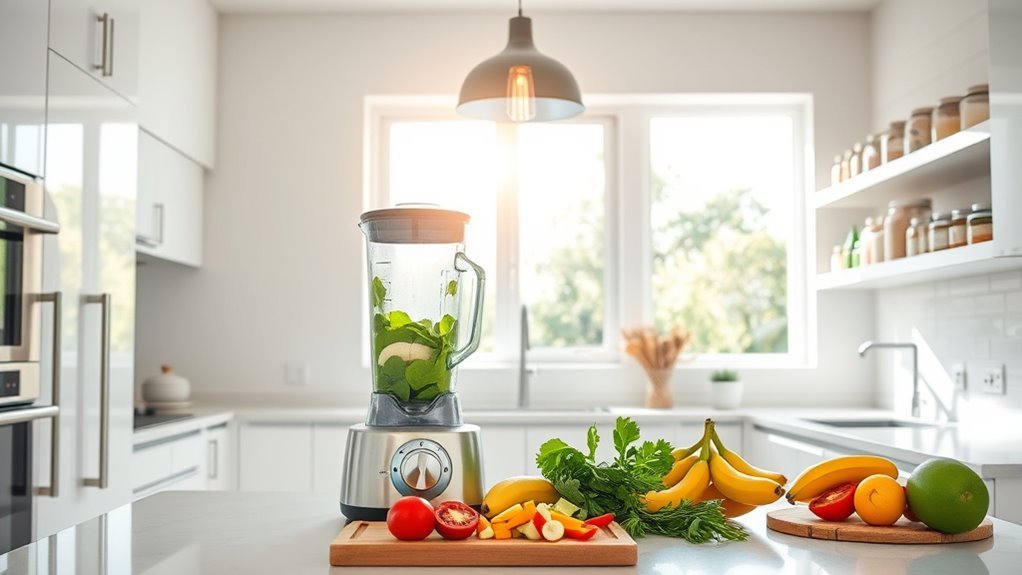We’ll help you slash your blender’s energy drain with three proven tactics. First, match wattage to your actual needs – 800-1200W handles most jobs just fine. Second, prep ingredients uniformly and use strategic pulsing instead of continuous blending, saving precious minutes. Third, leverage your blender’s eco-mode and auto-shutoff features while maintaining clean blades and tight seals. These fundamentals are just the beginning of mastering efficient blending techniques.
Choose the Right Wattage for Your Blending Needs

Three key factors determine your ideal blender wattage: ingredient toughness, batch size, and usage frequency.
We’ll help you avoid energy waste by matching power to purpose.
For most home kitchen tasks, 800-1200 watts hits the sweet spot.
Don’t automatically assume higher wattage means better – you might be paying to power capacity you’ll never use.
However, if you’re crushing ice or blending tough ingredients daily, investing in a 1200-1500 watt model makes sense.
Here’s why: less powerful units strain longer to achieve the same results, actually consuming more energy over time.
Smart tip: When batch processing, a robust motor powers through ingredients quickly.
You’ll slash active blending time and overall energy use compared to running a weaker model repeatedly. Moreover, a high-performance blender can help in achieving a more nutrient-rich diet by breaking down food more effectively.
Maximize Efficiency With Quick Blending Techniques
Having the right wattage is only half the battle – your blending technique makes or breaks energy efficiency. Let’s maximize efficiency with your powerful blender through smart, strategic methods that slash energy use.
| Action | Benefit | Time Saved |
|---|---|---|
| Uniform cuts | Even blending | 30-60 sec |
| Batch processing | Fewer cycles | 2-3 min |
| Pulse strategically | Quick results | 15-30 sec |
| Clean maintenance | Peak performance | 1-2 min |
| Size optimization | Faster blending | 45-60 sec |
We’ll get more done with less energy when we prep ingredients uniformly, process in efficient batches, and use the pulse function strategically. Keep that machine clean – it’s your secret weapon for quick, energy-smart blending. Remember: shorter blend times equal lower energy bills. Smart technique trumps brute force every time. By employing these methods, you can fully leverage your high-performance blender’s capabilities while minimizing energy consumption.
Smart Features and Habits for Power Conservation

Modern blenders pack powerful features that’ll slash your energy footprint – if you know how to use them.
Today’s Kitchen Appliances come equipped with auto-shutoff mechanisms and eco-modes that optimize power usage based on your blending needs.
We’ll get more done with less energy by batch processing larger quantities instead of multiple small blends.
Before firing up that powerful motor, prep ingredients completely – this cuts active blending time dramatically.
Smart features like variable speed settings lets match power output to the task at hand.
Don’t forget maintenance – a clean, well-oiled machine runs more efficiently.
Keep blades sharp, seals tight, and motors dust-free.
These habits guarantee your blender operates at peak performance while minimizing energy waste.
Frequently Asked Questions
Do Blenders Use a Lot of Electricity?
We don’t need to worry too much about blender electricity use. While they’re powerful, most run briefly. For better energy efficiency, consider manual blender alternatives for simpler tasks.
Does Higher Wattage Mean More Powerful Blender?
With up to 80% more blending power, higher wattage directly improves blender performance. We can see this in wattage comparison tests, where 1000+ watt models crush ice and nuts more efficiently.
How Many Watts Does a Blender Usually Use?
We’ll typically find blender wattage ranging from 800 to 1500 watts, with most home models around 1000 watts. Energy efficiency varies, but higher-powered units often complete tasks faster, using less overall power.
Is 1500 Watts a Lot for a Blender?
We’d consider 1500 watts astronomical for a blender! While it’s at the higher end of wattage comparison scales, we’re getting exceptional blender efficiency that helps tackle tough ingredients quickly.

